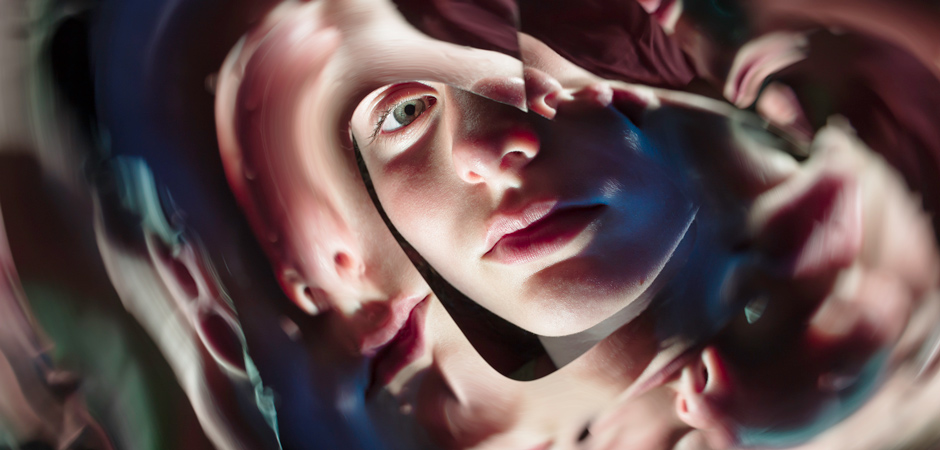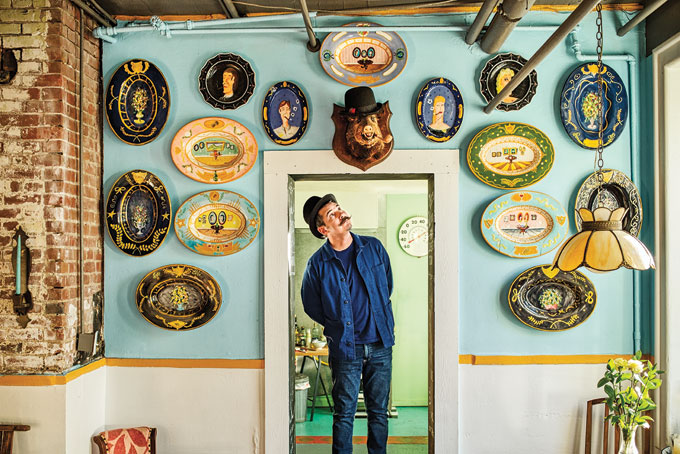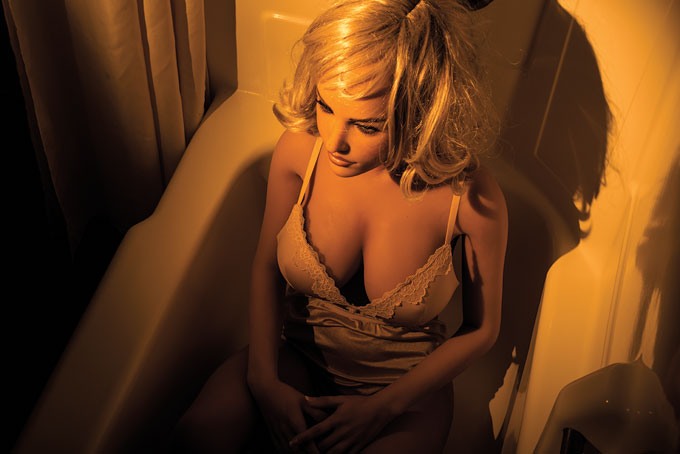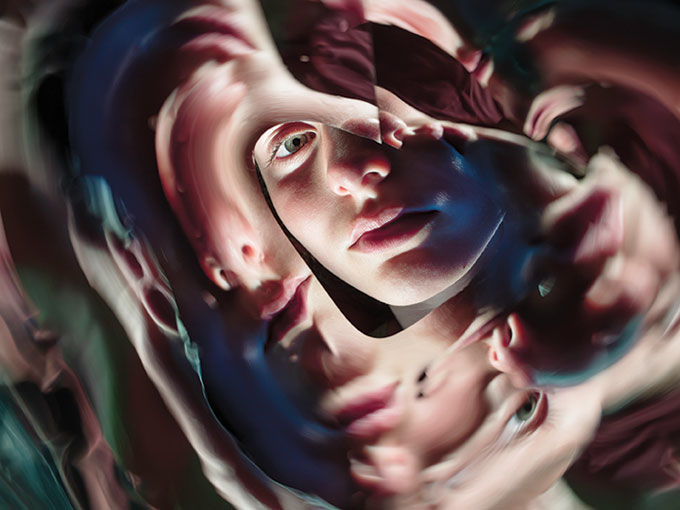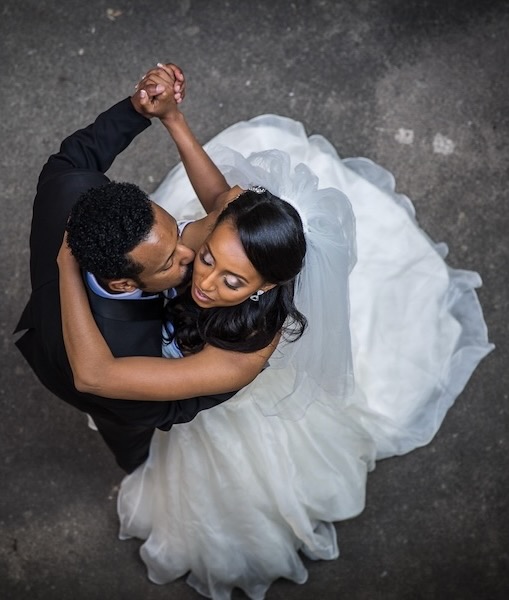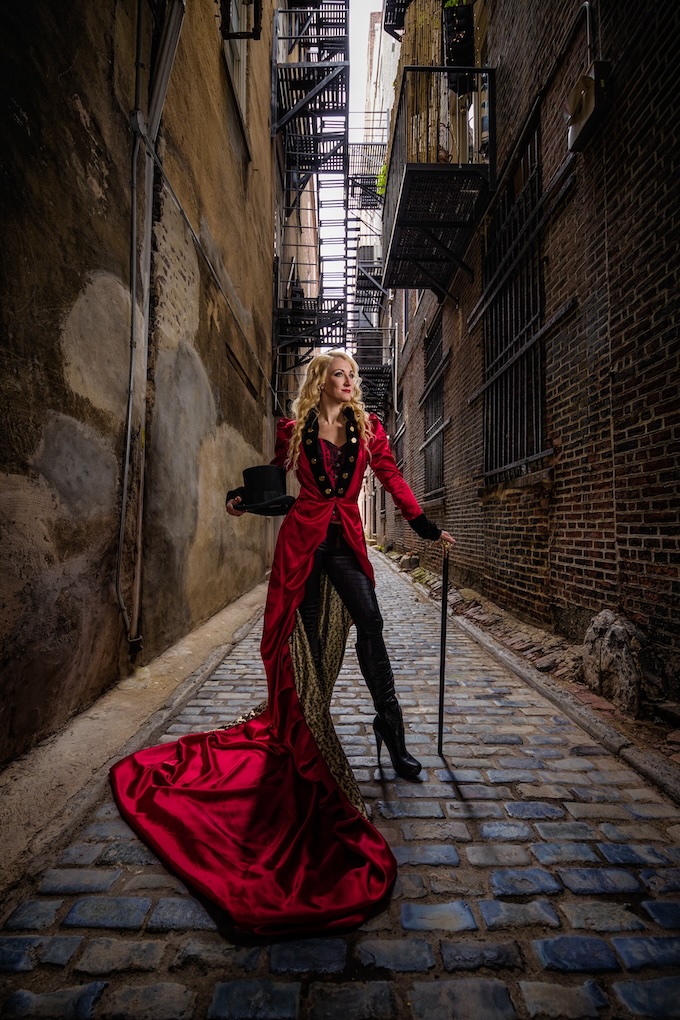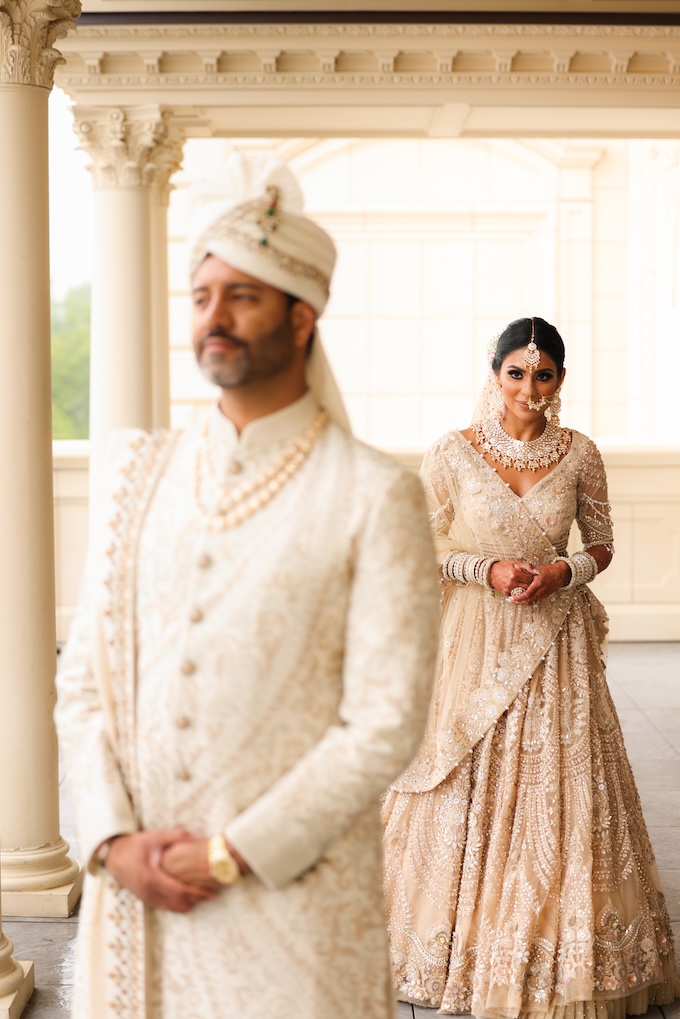Wedding + Portrait
The Rangefinder team was tasked with choosing just one impactful portrait from anywhere in the universe from this past year. Here are the riveting results, along with comments from the photographers on their approach.
FROM THE PHOTOGRAPHER, VANESSA GRANDA
I worked together with the team at Here magazine to choose a location where we could play off of a bit of the 1970s for this shoot with Queer Eye star Jonathan Van Ness. As the groomer on the show, his hair is so iconic, almost reminiscent of that period, so we wanted to make sure we complemented that well. This shot wasn’t too technical. I had him turn around into the mirror and give me different expressions until we got the one. We didn’t use any of the extra lighting we had—most of our light was coming from a large window to the left. Thankfully, we had a nice, evenly lit sky.
Jonathan was a dream to work with. He walked in and automatically told a joke, and then while we were shooting inside, we were all watching the royal wedding together and commenting on the outfits. We decided to shoot outside in the rain as well to show the busy-ness of New York City, and we were stopped several times by JVN fans. One even ran past us and came back to tell him that he and his wife were huge fans. Jonathan insisted on calling his wife and having a chat with her. It was such a sweet moment.
vanessagranda.com | @ohmynessa
FROM LIBBY PETERSON, FEATURES EDITOR
From an aesthetic standpoint, I was immediately drawn to the warmth in this image, especially as it doesn’t overpower the skin tones or whites. The temptation to push it to enhance the ‘70s vibe could have compromised it, but Vanessa Granda exercised an admirable level of tact that lets you focus on the subject. You don’t even notice right away that this was shot in a hotel room.
Technicalities aside, what I particularly love about this shot is its quietude. As someone who has seen all of Queer Eye, read the story on Jonathan Van Ness in Here and who receives positively honest quips from him via his posts on Instagram, I might be approaching this portrait with more knowledge on its intent than some. Van Ness likes to communicate his thoughts on the self—from unabashed self-care to inevitable self-doubt—and I felt immediately that Granda not only had done her research but clearly conceived of a way to communicate that subtly and powerfully. It speaks to a deep understanding of a subject, which is so critical to meaningful portraiture.
Camera: Canon 5D Mark IV
Lens: 50mm f/1.2 with Tiffen Glimmerglass filter
ISO: 400
Lighting: Natural
FROM THE PHOTOGRAPHER, STEPHEN AUSTIN WELCH
In this portrait of the renowned and ever playful artist MOCÓ, I wanted the viewer to sense the flavor of how MOCÓ blurs traditional boundaries between high and low art. Blending themes of pop culture with renaissance, MOCÓ has trumped initial naive strategies by choosing subject matter that is filled with not only cultural connotation, but also a tremendous amount of irony.
My artist portraits have been liberating as to who I am as a photographer now, resulting in the shucking of a lot of gear. Gone are the strobes, 12 x 12 silks and second setup motion camera. In making this series, I am breaking a lot of rules, using mostly bounce light and sponging off of practicals [like the the Christmas tree lights that were strung on the ceiling, used as a light source to expose the shot]. It‘s funny how creating a portrait of another person ends up being a self-portrait of the photographer.
FROM JACQUELINE TOBIN, EDITOR-IN-CHIEF
Environmental portraiture excites me. It serves as an anchor of sorts, not just in seeing a great image of the subject, but also getting to experience them in their surroundings—in this case MOCÓ’s residence/work space in an old military barracks building in Benicia, California, built in 1872—that furthers the connection for me of who the subject really is.
When I first saw this series of artist MOCÓ by Stephen Austin Welch (who has been a photographer and director for over 20 years), I was immediately struck by the whimsy and lightness in the underlying context of the image, but I also immediately got the sense that this person is important; that we should know him and would want to know him. As the photographer explains it: “I revel in creating portraits that mirror not only the artists themselves but also reflect the pulse of their work.”
Camera: Canon 5D Mark III
Lens: Canon EF 40mm f/2.8 STM
ISO: 400
Lighting: Sunlight, silver and white reflectors, a string of Christmas tree lights
Software: Lightroom, Aurora and Photoshop
FROM THE PHOTOGRAPHER, JOSHUA ARONSON
I just love this photo of Arvida Byström, a young Swedish photographer whose work explores femininity and the body. We made this around the time I was starting to question my own understanding of photography. Then, I wondered if my camera could be used for something more than just making the world pretty. I thought I could try and use my camera as a tool for building a community. This photograph comes from a series of portraits that explores this idea. I’m toying with what an aesthetic built around representing young, emerging artists today would look like, and shooting who I love at the same time, because back then it felt right.
FROM STACEY GOLDBERG, MANAGING EDITOR OF CREATIVE SERVICES
This year I had the honor of judging PDN’s Emerging Photographer competition, a submission-based contest that celebrates undiscovered and rising talents in our industry, which ultimately get printed in the biannual Emerging. Joshua Aronson’s series stood out from the pool of entries not only for his aesthetic, but also for the subject matter. In his submission, Aronson told us that his series, also called “Emerging,” highlights up-and-coming artists across all mediums—from musicians to furniture designers to fellow photographers. This image is representative of Aronson’s series, and it’s one of my favorites from the Spring issue of Emerging. I’m at once drawn to the pastel color palette and to the beauty and grace of his subject, even though she’s partially hidden by flower petals in the foreground. It’s an element that makes her direct, single-eye stare feel slightly uneasy but fully captivating.
Camera: Pentax SF1n
Lens: Pentax SMC 50mm f/1.8
Film Stock: Kodak Portra 400 35mm
Lighting: Natural
FROM THE PHOTOGRAPHER, TANIA FRANCO KLEIN
When I was first approached by Jody Quon, New York magazine’s photography director, to take pictures of sex robots, she told me that she wanted to bring them to life. The sex robots are obviously sexual objects, but it was important for us to keep the work sophisticated and psychologically driven, which is how I approach all of my work.
The idea was to generate an atmosphere of truth and to paint a picture of how reality with a sex robot might be. I couldn’t help but associate the feeling of loneliness with the experience of being with a sex robot. What was most fascinating for me was how much these dolls are a reflection of the times we are living in now. Technology is playing a big role in creating a sense of empty companionship, and this project very much reflects the broken social tissue that a big part of our society is experiencing.
There were many challenges around making the project work, including finding an interesting location close to the robots’ factory. It took me a few days to find an old motel in the area where we could sneak in with two life-size sex robots without getting noticed by the receptionist. The creators of the robots brought them in personally, and it was very surprising that moving the robots was actually a very complicated task. I had to be precise with what they were wearing and how they were sitting because the whole process of dressing them and moving them around took half an hour. It was certainly one of the most bizarre and unique experiences I have had as a photographer. It is not every day that you’re tasked with thinking about life with a sex robot.
taniafrancoklein.com | @taniafrancoklein
FROM ZACHARY GILYARD, ART DIRECTOR
I love when I can look at a photo in a magazine and understand the story without first reading the words. This series in New York magazine by Tania Franco Klein delivered by giving me a complete visual and emotional story simultaneously.
We often see synthetic human beings in futuristic films and television. I think about the film Blade Runner by Ridley Scott or HBO’s Westworld and how the line between human and machine might one day be nearly impossible to identify. This image bridges that gap between the present and a future we now only see in movies. These robots are not alive, but one day could be.
The hard shadows and warm color tones of the lighting create a dystopian and lonely narrative. The quiet, casual posing really brings the robot to life. All of these aspects combined take the image from a still life of a non-living thing to a portrait of woman with a story to tell. Klein successfully conveys human emotion despite the absence of human life.
Camera: Nikon D600
Lens: 50mm
Exposure: f/13 at 1/160 sec.
ISO: 125
Lighting: Nikon flash
FROM THE PHOTOGRAPHER, EDITH MAYBIN
Teenagers are enigmatic by nature, so when I set out to make this portrait of my then 13-year-old daughter, I wanted to combine this idea with my experience of her beauty and wit. This portrait is part of a 12-year project, made up of five photographic series presented as “Documents,” which I started when my daughter was 4. This particular image is from the Girl Document, which is about tweendom, a stage of her development I found particularly dimensional. To make this kaleidoscopic approach to lensing, I made a short silver mylar snoot and taped it to the perimeter of my lens. I felt the use of the portal, the simplicity of the technique and the intricate outcome expressed the complexity and humor developing within her identity.
edithmaybin.com | @edithmaybin
FROM GREG SCOBLETE, SENIOR TECHNOLOGY EDITOR
When I first encountered Edith Maybin’s portrait of her daughter, I was struck in equal measure by its unorthodox technique and the underlying symbolism of an identity in flux. As a parent of a newly minted teenager, I’ve had a front row seat to the vortex of emotions that accompany the transition from childhood to adulthood. It’s often said that teenagers try on many different personalities in the course of self-discovery, and this image beautifully evokes that sense of disequilibrium. Beyond that, I’m a fan of work that provokes questions, and this raised several for me: Is the subject’s core identity disintegrating, shedding its youthful self in favor of a still indeterminate adulthood, or is it swirling into being before our eyes? Has it been there all along, centered amidst the chaos and confusion of those teenage years? Or maybe this image is telling us that we’re all destined to be in something of a state of transition, our personas and self-image in a constant state of dynamism and reinvention.
Camera: Mamiya 645 with Phase One P45+ back
Lens: 35mm
Exposure: f/10 at 1/8 of a sec.
ISO: 200 Lighting: Homemade silver snoot
Related: 3 Ways to Mix Up the Usual Portrait Lighting Set-Up
How Photographers Are Embracing Ambient Light
Are Studio Portraits Making a Comeback in the Photo Industry
How to Get Weddings and Portraits Published in Major Publications

